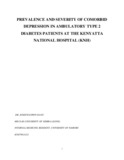| dc.contributor.author | Kanu, Joseph, E | |
| dc.date.accessioned | 2016-04-20T07:48:22Z | |
| dc.date.available | 2016-04-20T07:48:22Z | |
| dc.date.issued | 2015 | |
| dc.identifier.uri | http://hdl.handle.net/11295/94337 | |
| dc.description.abstract | Background: Diabetes mellitus and depression are emerging health problems in developing countries including sub-Saharan Africa.
Depression is a serious co-morbid condition in diabetes patients that negatively affects self-management, drug adherence, treatment outcomes and quality of life.
Various studies have shown that depression is still largely unrecognized by health care providers managing patients with diabetes and even when recognized only one-third of patients with diabetes and depression are appropriately treated.
Objective: To determine the prevalence and severity of co-morbid depression in ambulatory type 2 diabetes patients at KNH and to document the socio-demographic and clinical characteristics of the study population with depression.
Methodology:
Study design: Cross-sectional descriptive study.
Study site: Outpatient diabetes clinics at KNH.
Subjects: Ambulatory type 2 diabetes patients on follow up at KNH.
A systematic sampling method was used to recruit 220 subjects from the diabetic clinic in KNH and the PHQ-9 was used to assess for depression. Socio-demographic and clinical details were obtained from patients and medical records. BMI and blood pressure were measured. Blood samples were collected to measure HBA1C as a parameter for glycaemic control Statistical associations of patients characteristics and co-morbid depression was analyzed using Chi-square test.
Results: The prevalence of comorbid depression in patients with type 2 diabetes at the DOPC in KNH using the PHQ-9 was 32.3%, of which 13. 6% had mild depression, 13.2% had moderate depression and 5.5% had severe depression. Increasing age > 65years (p=0.006), longer duration of diabetes ≥ 5years (p=0.044) and over-weight/obesity (p=0.035) were significant associations with co-morbid depression.
xii
A significant proportion of patients with comorbid depression had poor glycaemic control with HBA1C > 7% (39.2%) compared to 16.4% with good control (HBA1C ≤ 7%).
Conclusion About one-third (32.3%) of the study subjects with type 2 diabetes had comorbid depression and more than half (18.7%) had moderate to severe depression.
This study attempts to explore potential risk factors for comorbid depression in type -2 diabetes patients in KNH. Older age (>65years, p=0.006), longer duration of diabetes (≥ 5years, p= 0.044) and over-weight/obesity (≥ 25Kg/m2 , p= 0.035) were found to be associated with comorbid depression. | en_US |
| dc.language.iso | en | en_US |
| dc.publisher | University of Nairobi | en_US |
| dc.subject | Prevalence and severity of co-morbid depression | en_US |
| dc.title | Prevalence and severity of co-morbid depression in ambulatory type 2 diabetes patients at the Kenyatta national hospital (knh) | en_US |
| dc.type | Thesis | en_US |
| dc.description.department | a
Department of Psychiatry, University of Nairobi, ; bDepartment of Mental Health, School of Medicine,
Moi University, Eldoret, Kenya | |

